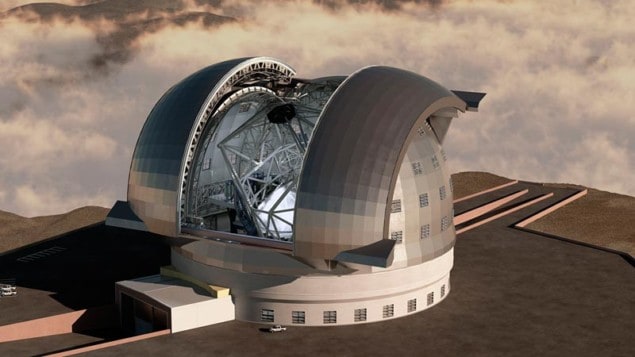
A site at Cerro Armazones in Chile has been chosen for a new €1bn super telescope being planned by the European Southern Observatory (ESO). The site for the European Extremely Large Telescope (E-ELT) was selected yesterday by the ESO Council from a shortlist of five, beating off three others in Chile and one at La Palma in the Canary Islands.
Cerro Armazones, which is about 20 km from ESO’s existing Paranal Observatory, was picked because it has the “best balance of sky quality across all aspects” and because the 42 m diameter E-ELT could then be operated in “an integrated fashion” with the Paranal Observatory, which is home to ESO’s existing Very Large Telescope (VLT).
“Adding the transformational scientific capabilities of the E-ELT to the already tremendously powerful integrated VLT observatory guarantees the long-term future of Paranal as the most advanced optical/infrared observatory in the world,” explained Tim de Zeeuw, ESO’s director general.
‘Ambitious project’
“This is an important milestone that allows us to finalize the baseline design of this very ambitious project, which will vastly advance astronomical knowledge,” de Zeeuw added.
E-ELT’s primary mirror will be 42 m in diameter, made from 984 smaller segments that are each 1.45 m wide. The secondary mirror will be up to 6 m in diameter. A tertiary mirror will pass the light on to a comprehensive adaptive-optics suite, consisting of another two mirrors, one of which will be continuously shape-controlled by more than 5000 actuators, thereby correcting for any blurring caused by the Earth’s atmosphere.
The telescope will be sensitive enough to detect reflected light from Jupiter-like and potentially Earth-like planets orbiting stars other than the Sun – and will try to probe their atmospheres using low- resolution spectroscopy. It will even be able to detect water and organic molecules in gas clouds around stars, thus providing clues as to which planets may become habitable in the future.
Construction of the facility is expected to begin at the end of 2010 and the telescope should be operational by 2018.
Two more big projects
E-ELT is not the only large telescope in the planning stages. The Thirty Meter Telescope (TMT) will be built by a Canada/US consortium at Mauna Kea in Hawaii and should also be operational by 2018. TMT’s 30 m diameter mirror will be made from 492 individual segments. The telescope will operate in wavelengths from ultraviolet to mid-infrared, enabling astronomers to study the origin and evolution of planets, stars and galaxies.
An Australia/US consortium plans to build the Giant Magellan Telescope (GMT) at Cerro Las Campanas in Chile. This instrument will have a primary mirror consisting of six 8.4 m diameter individual segments surrounding a seventh central mirror. The GMT could be working by 2018 and will seek to shed light on planets beyond our solar system, determine the nature of dark matter and dark energy, study the origin of chemical elements and investigate the growth of black holes. It will operate at visible, near- and mid-infrared wavelengths.



